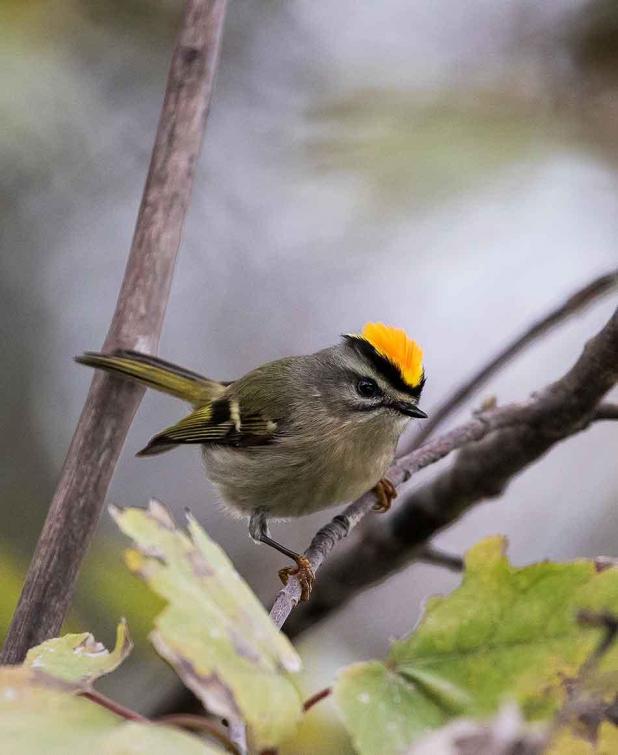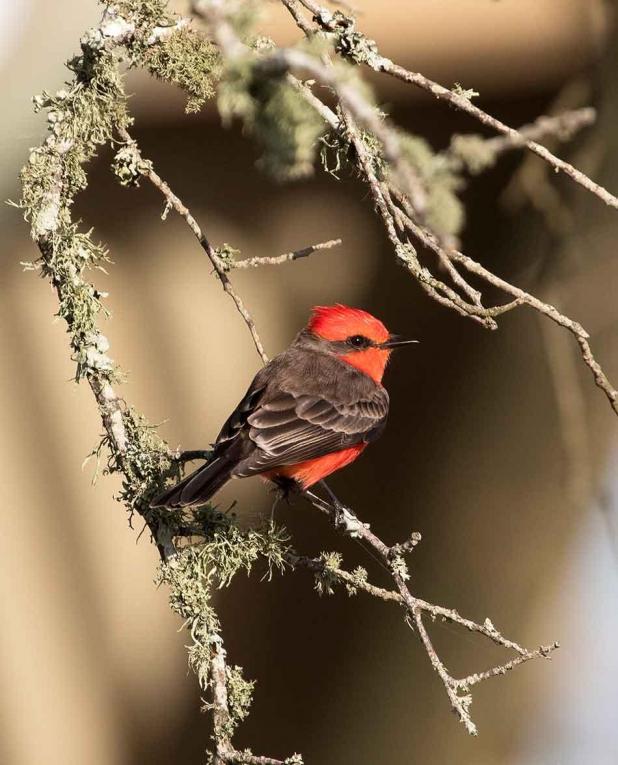
A Golden-crowned Kinglet along Cotten Road in Patterson.
—John Flores photos

A Vermilion Flycatcher at Cypremort Point State Park Thanksgiving weekend that is spending winter there for the second year in a row.
Winter birding: An exciting time for great discovery
A lacy frost blanketed the marshes and countryside of St. Mary Parish the week. At dawn, the frost met a spectacular sunrise, where under a brilliant blue sky the two kissed. And afterwards, the early December frost glistened and sparkled, like most things do when the countdown to Christmas begins moments after the last bites of Thanksgiving dinner are shared.
Flitting outside in the swamp maples, willow, and cypress trees above the frosty ground were tiny feathered visitors who reached our coastline in the weeks leading up to the holiday season. They always come at this time each year just to spend the winter with us.
Some will migrate a thousand miles or more to make Louisiana their seasonal home. And though our local trees begin to look like leafless skeletons to us, with temperatures that force us southerners into our coats, the birds find our climate much more temperate than the snowy north.
Moreover, unlike their northern home blanketed in snow resting lifeless in the gray and white shadows of Old Man Winter, they find our fields and marshes full of food and the necessary comforts to gain fat for next spring’s breeding season.
If you’re a person who enjoys bird watching, whether at a backyard feeder or along a walking trail, winter can be a special time to see things that only northerners typically see throughout much of the year.
Bayou Vista resident and President of the Terrebonne Bird Club Paul Schaub considers the winter birding season one of the best times of the year to go birding along the Louisiana coastline.
Schaub said, “Winter is my favorite time of the year to bird all because of sparrows. They are my favorite species. On any particular trip it is not uncommon to see or get pictures of four to six different sparrows. The different types I see around here are Swamp Sparrow, probably the most common and you can tell why by the name — Savannah, Chipping, White-throated, White-crowned, and Song.”
Schaub says on a good day a birder may even get to see a Vesper Sparrow or even a rare Fox Sparrow around the area. Also, Juncos might be found that he notes is in the sparrow family of birds though sometimes hard to identify even by some of the most experienced birders.
Rare birds seem to bring intrigue and not just from local birders in a particular region, but often times from beyond a state’s borders.
One such bird happens to be the Fork-tailed Flycatcher. Over the past several years this species, whose range is typically found in the grassland and lightly forested regions from southern Mexico southward beyond Argentina, has been sighted in southwest Louisiana; particularly, Calcasieu and Cameron parishes.
David Booth, who serves as Vice President of Programs for the Gulf Coast Bird Club – Lake Charles and Vice President of the Louisiana Ornithological Society, classifies the Fork-tailed Flycatcher’s occurrence to southwest Louisiana as not only rare, but perhaps even accidental.
According to the American Birding Association’s checklist codes that range from Code 1 to Code 6, rare would be considered at a minimum Code 3.
Booth, who happened on a Fork-tailed Flycatcher back in January 2018 south of Lake Charles while birding said, “It’s just an unusual bird. I guess we have the right habitat. The short grass. The kind of short pasture that they must like, because they keep coming back. The current one hanging out around Fabacher Road might be the same bird that I found nearly three years ago. It’s been basically in the same spot which is neat and it’s like a level 4 or 5 in rarity.”
Just to further understand ABA rarity, their literature defines Code 4 as “casual” where the species is not recorded annually in the ABA Checklist Area, but with six or more total records — including three or more in the past 30 years.
Code 5 is defined as “Accidental,” where a species is recorded five or fewer times in the ABA Checklist Area, or fewer than three records in the past 30 years.
Booth said, “It’s very, very rare and extremely hard to find in the United States. Basically, we have some of these people doing a ‘Big Year’ and big counts that need that bird. We had people come from Australia and Chicago coming to see that bird to count it and check it off their lists. It was amazing.
“We had people show up by the scads,” Booth continued, “and we were making the landowners a little upset. But, the Sheriff’s Department was very congenial and they made sure we were safe with all these cars parked on the side of the road. The birds would come out every day and be somewhere in a half mile of the vicinity. They’re flycatchers, so they would swoop and sail. It was just artistic.”
Both Booth and Schaub are involved in the Audubon Christmas Bird Count haled as the nation’s longest-running community science bird project dating back to 1900. Before it was the Christmas Bird Count it was known as “The Christmas Side Hunt.” During the late 1800s, hunters participated in essentially a competitive shoot, where anything was fair game and the biggest pile of feathers won.
With the onset of conservation-minded ornithologists and individuals realizing it wasn’t the right thing to be doing, the hunt was changed becoming the “Christmas Bird Census.” A complete history of the Christmas Bird Count is available at https://www.Audubon.org/conservation/history-christmas-bird-count
The CBCs are conducted across the nation in a 15-mile diameter circle centered at preapproved points, where the goal of participants is to count every bird seen or heard possible in the circle during a 24-hour period. And, you don’t have to be an expert to be involved — novice birders or people interested in birding are welcome.
Booth said, “The data goes into a data bank and a lot of studies are done with bird count data, because they try to repeat it every year in the same spot with the same information. It’s used to help develop population trends and determine if some species are losing ground or gaining ground. So, that’s the general idea, but the census has been done for 121 years now and it’s a vast, vast amount of data available to use and study.”
Besides sparrows, Schaub says he also looks for various raptors, White Pelicans, warblers and kinglets during the winter.
This past weekend along Cotten Road next to Kemper Williams Park, I spotted a few Golden-crowned Kinglets. The diminutive bird is chickadee size and extremely busy, as it flits about searching for food in the branches of trees.
The little olive-colored bird has a striking stripe of yellow feathers that run down the middle of its head and when excited raise to a flaming orangish-yellow tiara. It was a short winter birding trip that allowed me to see this particular species.
In Louisiana there are always birds coming and going, making it one of the top five birding states in the United States. And for locals here in St. Mary Parish, you don’t have to go far to enjoy them.
